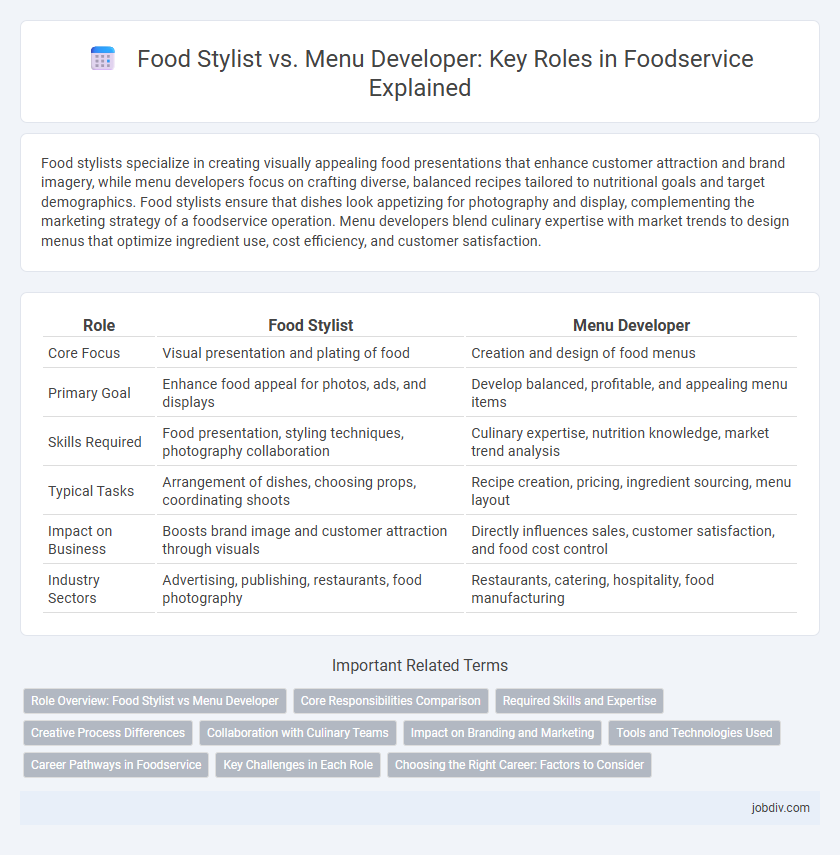Food stylists specialize in creating visually appealing food presentations that enhance customer attraction and brand imagery, while menu developers focus on crafting diverse, balanced recipes tailored to nutritional goals and target demographics. Food stylists ensure that dishes look appetizing for photography and display, complementing the marketing strategy of a foodservice operation. Menu developers blend culinary expertise with market trends to design menus that optimize ingredient use, cost efficiency, and customer satisfaction.
Table of Comparison
| Role | Food Stylist | Menu Developer |
|---|---|---|
| Core Focus | Visual presentation and plating of food | Creation and design of food menus |
| Primary Goal | Enhance food appeal for photos, ads, and displays | Develop balanced, profitable, and appealing menu items |
| Skills Required | Food presentation, styling techniques, photography collaboration | Culinary expertise, nutrition knowledge, market trend analysis |
| Typical Tasks | Arrangement of dishes, choosing props, coordinating shoots | Recipe creation, pricing, ingredient sourcing, menu layout |
| Impact on Business | Boosts brand image and customer attraction through visuals | Directly influences sales, customer satisfaction, and food cost control |
| Industry Sectors | Advertising, publishing, restaurants, food photography | Restaurants, catering, hospitality, food manufacturing |
Role Overview: Food Stylist vs Menu Developer
Food stylists specialize in creating visually appealing food presentations that enhance photography and advertising, using techniques to make dishes look fresh and appetizing under various lighting conditions. Menu developers focus on designing and optimizing menus by selecting ingredients, balancing flavors, and considering cost-efficiency and customer preferences to increase restaurant profitability. While food stylists prioritize aesthetics and visual impact, menu developers emphasize culinary innovation, nutritional value, and operational feasibility.
Core Responsibilities Comparison
Food stylists specialize in creating visually appealing food presentations by carefully arranging dishes to enhance their aesthetic appeal for photography and marketing purposes. Menu developers focus on designing and testing recipes, balancing flavors, and creating diverse, cost-effective menu offerings that meet nutritional standards and target customer preferences. Both roles require culinary expertise, but food stylists prioritize visual impact, while menu developers emphasize recipe innovation and operational feasibility.
Required Skills and Expertise
Food Stylists require expertise in visual presentation, food texture manipulation, and an understanding of lighting and photography to create visually appealing dishes for marketing materials. Menu Developers need strong culinary knowledge, nutritional insight, and market trend analysis skills to design balanced, innovative menus that meet customer preferences and dietary requirements. Both roles demand creativity, attention to detail, and collaboration with chefs, marketers, and kitchen staff to enhance the overall dining experience.
Creative Process Differences
Food stylists focus on the visual presentation and aesthetic appeal of dishes to enhance photography and marketing materials, employing techniques like color coordination, texture manipulation, and plating artistry. Menu developers concentrate on creating balanced, innovative menus by researching trends, flavor profiles, customer preferences, and nutritional considerations to design cohesive meal options. The creative process for food stylists is centered on visual impact and storytelling through food appearance, while menu developers engage in flavor innovation, ingredient selection, and operational feasibility.
Collaboration with Culinary Teams
Food stylists and menu developers collaborate closely with culinary teams to create visually appealing and innovative dishes that align with the brand's identity and customer preferences. Food stylists focus on presentation and photography to ensure dishes look enticing, while menu developers concentrate on ingredient selection, flavor combinations, and nutritional balance to craft cohesive menus. Their collaboration enhances both the aesthetic appeal and the overall dining experience, driving customer satisfaction and sales growth.
Impact on Branding and Marketing
Food stylists enhance branding by creating visually appealing dishes that elevate a restaurant's image and attract customers through compelling food photography and presentation. Menu developers drive marketing by designing diverse, innovative menus that align with brand identity and cater to target audiences' preferences, boosting customer engagement and sales. Both roles are crucial for crafting a cohesive brand experience that differentiates a foodservice business in competitive markets.
Tools and Technologies Used
Food stylists primarily use high-resolution cameras, specialized lighting equipment, and props to create visually appealing dishes that enhance food presentation for photography and advertising. Menu developers leverage data analytics software, recipe costing tools, and nutritional analysis programs to design balanced, cost-effective menus tailored to target demographics and dietary trends. Both roles integrate digital platforms such as Adobe Photoshop for image editing and cloud-based recipe management systems to streamline collaboration and innovation in foodservice.
Career Pathways in Foodservice
Food stylists specialize in creating visually appealing food presentations for photography and media, often collaborating with photographers, chefs, and marketing teams to enhance brand appeal. Menu developers focus on designing diverse, cost-effective, and nutritionally balanced menus tailored to specific customer bases, working closely with culinary teams and nutritionists. Both career pathways require strong culinary knowledge, creativity, and understanding of consumer trends, but food stylists lean towards artistic food presentation, while menu developers emphasize menu strategy and operational efficiency in foodservice settings.
Key Challenges in Each Role
Food stylists face the key challenge of creating visually appealing dishes that maintain freshness and color under photography lighting while balancing artistic presentation with realistic food textures. Menu developers must address the complexity of balancing nutritional value, cost-effectiveness, seasonal ingredient availability, and consumer taste preferences to design profitable, relevant menus. Both roles require collaboration with chefs, but menu developers often encounter stricter constraints related to operational feasibility and supply chain logistics.
Choosing the Right Career: Factors to Consider
Food stylists specialize in enhancing the visual appeal of dishes through plating, lighting, and photography, making them ideal for careers in advertising or media. Menu developers focus on creating innovative recipes and balancing nutritional content, catering to restaurants aiming for diverse and profitable offerings. When choosing between these careers, consider your passion for creativity in presentation versus culinary innovation, as well as your preferred work environment in visual arts or food production.
Food Stylist vs Menu Developer Infographic

 jobdiv.com
jobdiv.com